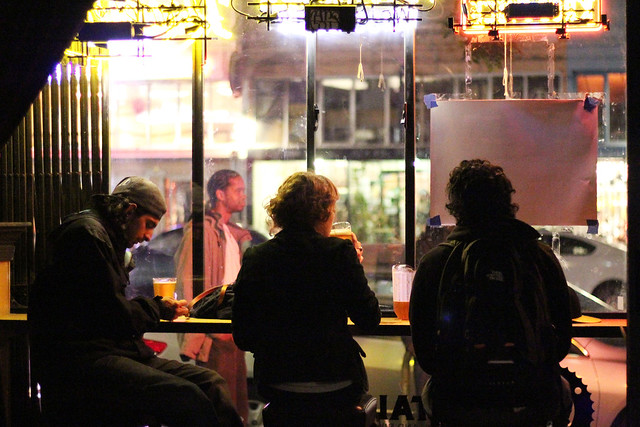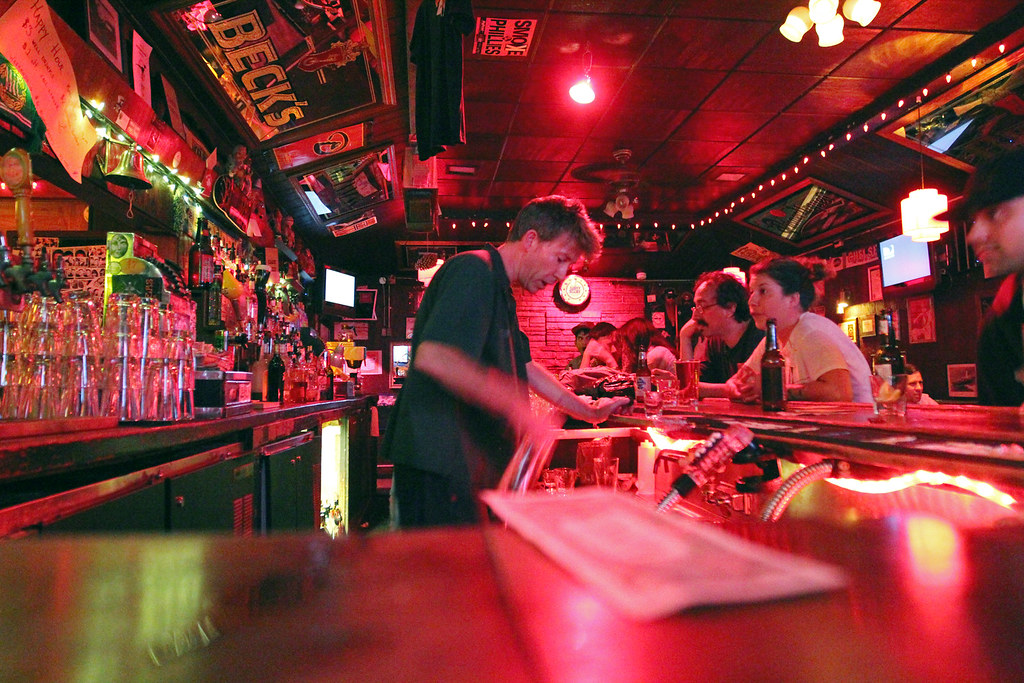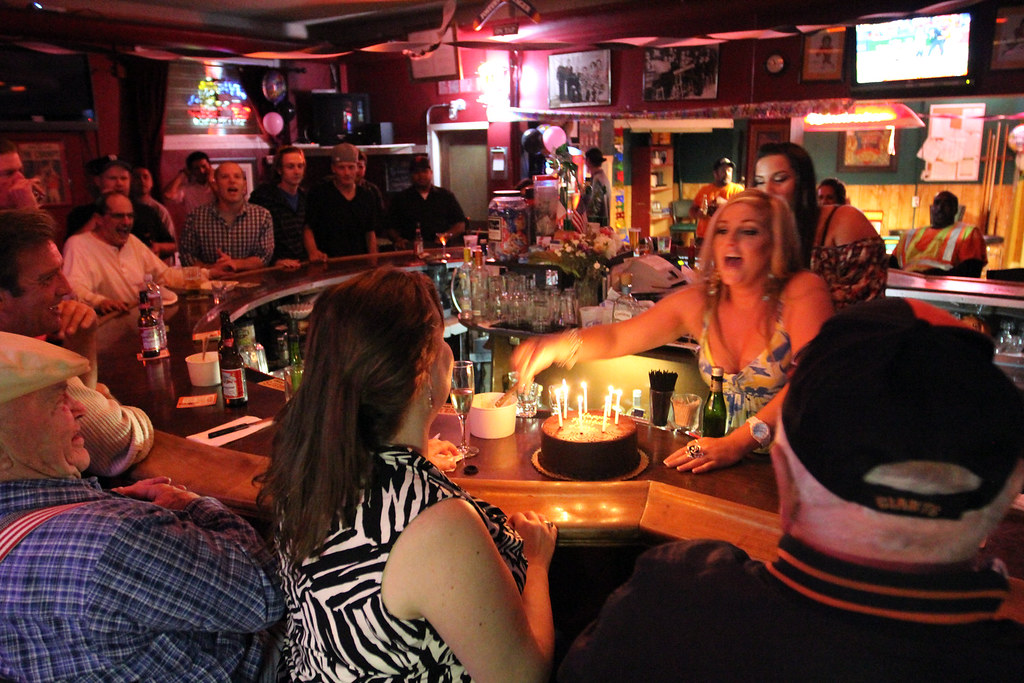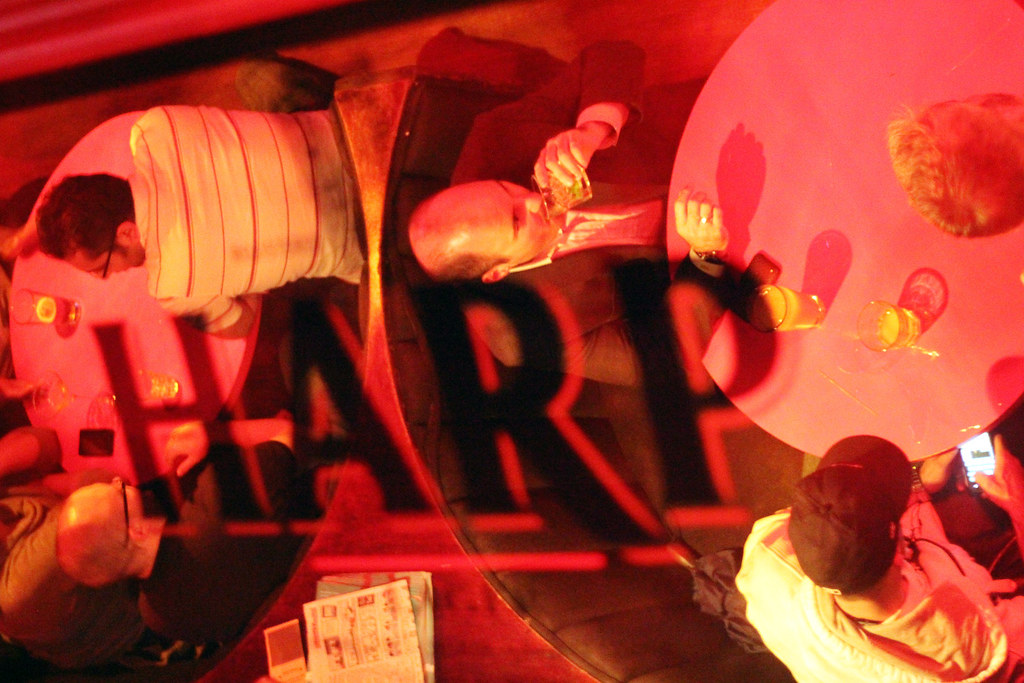“Bars like this are a dying breed here,” explains Isaac Fitzgerald, writer, editor and dive bar aficionado. What the young Boston transplant is talking about are Mission district dive bars. Open the door to any one of the bars that line the district’s corridors and drinkers are met with an atmosphere where anything goes and it’s almost impossible to be thrown out. The chiseled faces and rough hands of the regulars make the scene as they talk and joke with bartenders who have been slinging drinks in this city for the last thirty years. Rough and tumble dive bars used to dot Mission streets like mosquitos on a warm damp night, but as the years go by and the area changes, many of the places just aren’t what they used to be.
“A dive bar is somewhere you can show up any old time and know you’re going to get a spot,” says Josh Spainhoward, an Ohio native and San Francisco transplant who has been drinking in Mission dive bars for the last seven years. “You can belly up, order a shot and a beer and stare in the mirror and nobody’s’ going to say hello. The bartender will be around when your glass is empty and that’s it,” Spainhoward explains as he takes a drag on his cigarette and sip of his pint and lounges on an outdoor patio on a rare, balmy San Francisco night.
The Mission district is called a “city within a city” for a reason. The area has been a longtime home to San Francisco’s working class, from the Irish, German and Italians to the current Latino population – the small district has opened its city streets and bar doors to the day laborers and the downtrodden. Wander away from the main thoroughfares of the district and in the back alleys and hidden corridors, and that is where the real dive bars are found. “They’re somewhere you go to drink and stare at the wall and kinda daydream and chat it up with those around you, but for the most part you’re there to drink and not do anything else,” Spainhoward elaborates, a half full pint in his hand and a small smile on his blond haired, blue eyed Midwestern face. These are bars without rules and pretensions, bars where patrons don’t go to be seen or be a part of any scene; they go to drink with friends who are closer to family and mingle with people from all walks of life.
“A dive bar is a place where you can’t get thrown out,” explains Fitzgerald as he sits back in his barstool with a Bud in his hand. The light streams down through a dirty window and the Giants score another home run. It is only three in the afternoon on a Sunday and already regulars are blitzed. Old men with long gray hair tied back into ponytails clink beer bottles over baseball victories as Deb continues to keep the beer caps popping and liquor flowing.
“Let me tell you a story that happened here (at Clooney’s),” says Fitzgerald, while his hands grip the beer bottle and the crowd around the bar lets out a collective sigh over a ball game disappointment. “I was in here on a Sunday afternoon, much like this, but there was no sports so there was a much thinner crowd. These 4-5 Irish guys who had obviously been up all night doing drugs were just in here getting drunk and this one girl was talking to one of the guys and then started talking to the other. The guys’ tempers rose, and after having been a bouncer at Zeitgeist, I just saw what was about to happen.” Fitzgerald’s voice starts to rise as his hands gesticulate in time with the story.
“The guys go at each other’s throats so I actually grab them throw them outside, I come back inside, I’m feeling really good about myself and they peek their heads in.” At this point Fitzgerald sighs and shakes his head, seemingly in disbelief at the story he is telling and the words that are coming out of his mouth. “And the bartender doesn’t blink. She just says ‘Guys if you’re willing to calm down you’re more than welcome to come back in, stay and have a drink.’ They come back in and immediately start a fight. A chair gets broken, they knock over the bubble gum stand. Again we throw them outside and bolt the door, cops come, cop walks in and before anyone could say anything the bartender was like ‘They won’t come in here, I’ve never seen those guys before in my life.’ And I was just floored. You cannot get kicked out of this bar. You really can’t, and that’s the kinda stuff that happens at a dive bar. Part of it has to be what’s allowed.”
Clooney’s, and other dive-y places that line the Mission district corridors have a rich history. Though the area is currently known to have a primarily Latino population, it wasn’t always like that. After the infamous 1906 earthquake, the district was home to mainly Irish. According to Kevin Mullen, a San Francisco native with Irish-born parents, in an interview with local news outlet KALW, after the devastation of the 1906 earthquake and fires, the Irish population moved out of SOMA and into the Mission. Mullen tells KALW that the Mission soon came to be known as the Irish district and that the “Mission Irish” were “a little more rough-edged than other types of people.” As the Irish started to flood the Mission district, so did Germans and Italians. It was this wave of culture in the early 1900’s that established the Mission as a rough and tumble working-class neighborhood.
Currently, many people equate the Mission district to a hotbed of Latino gang activity and violence. And while that isn’t far from the truth, the area was once home to an overwhelming majority of San Francisco’s Latino day laborers. Since residents have first planted roots and started working in San Francisco, districts have grown and changed depending on population shifts. It wasn’t until the 1930s that the Mission started to gain the reputation and population it has now. As is the story with most population redistribution in San Francisco, the whole thing started with rent prices.
In the 30s, San Francisco’s Latino population lived in North Beach, but rent prices started to skyrocket and the first place the forced out population found to go was the Mission district. They started at 16th Street and worked their way into the small landscape, changing the dynamics of the area and politics of the district. As the 30s turned into the 40s more Latino immigrants came from South America and Mexico and made a home in the working-class neighborhood. As the area started to grow and change, so did the drinking establishments.
Mission bars became meeting places for locals, but for immigrants they were much more. MissionMission, a blog about the Mission district culture featured a Mission Loc@l piece about longtime Latino dive bar El Tin Tan. The bar is located on 16th Street, in between a taqueria and a dingy residential hotel whose barricaded door has a broken lock and Spanish instructions hanging in the window. The small bar, crowded in the middle of chaotic streets, armed with a heavy door and pulsating Mexican pop music is more than a place to get a beer for immigrants—it is an opportunity to start a life. “Informal meeting places where immigrants gather and hear about job opportunities have always been vital to settling in America. Despite its humble appearance, El Tin Tan is one of these places, famous…as a key stop in the United States for Latinos hoping to escape poverty in their home countries,” according to the article.
The Mission district’s population is once again going through a radical change. Once it was immigrants who flocked to the dingy streets in hopes for a better life, free of whatever was binding them in their oftentimes Latin American home countries. Now, the transplants are white kids. Urban twenty-somethings are attracted to the Mission for its budding art scene, flurry of new restaurants and cheap rent in one of the most expensive cities in the United States. “Young people who work at Google are coming in, and those people want style, they want clean bathrooms. As the neighborhood changes we’re seeing a decline in dive bars. But that’s because the secret is out: this is a great city, everybody loves it and it’s kinda like this resurgence,” explains Fitzgerald. In an attempt to expand horizons, young and hip bar owners are buying out places that were once owned and operated by Mexicans—in one recent example, a Mission district Latin dance club is being renovated to be a French gastropub.
These small bars, where anything goes and the world could either be a pearl or a rock, used to be a staple of the once working class Mission district. Now the grizzled regulars are slowly being replaced by the city’s young, hip and rich. “They’re turning dive bars into destination spots,” explains Bill Bergstrom, a San Francisco native, San Francisco State graduate and longtime dive bar patron. “I’ve seen it the most in the 500 Club and the Gestalt Beerhaus.”
The 500 Club, at the corner of Guerrero and 17th Street, was once a working class staple. The dimly lit semi-spacious dive bar was home to a group of Latino blue-collar workers, a hot rod car club, the 500ers, and off-duty bike messengers. The Vegas style sign that runs horizontal along the front of the building advertised the bar opening at 6 a.m. Bergstrom sits back and reminisces of evenings past when he and friends would be able to take refuge with the day laborers, car enthusiasts and messengers – the 500 Club was a place to get away and hide for awhile. The bartender was curt, the drinks were strong and the decor was non-existent.
With a deep sigh and a heavy heart, Bergstrom guesses it was about five years ago that the bars started to change. “Suddenly on a Saturday night you were unable to get service.” With the change in neighborhood came a change in the patrons. The bars were slowly but surely attracting a new crowd, a group of people who came from all over the city. The locals weren’t the ones sitting on the ancient bar stools anymore; it was the new wave of Mission hipsters and visitors from other parts of the city. “They were taking people who used to enjoy local flavor and pushing them to other neighborhoods,” explains Bergstrom.
The 500 Club isn’t the only dive bar guilty of trading the title of dive to that of destination. The once dive bar Zeitgeist is perhaps one of the most infamous to do so. According to Fitzgerald, Zeitgeist has had an interesting history. The large bar, known mostly for it’s outdoor seating, disgusting portable bathrooms, strict rules, juicy burgers and punk rock jukebox, was originally a gay bar. When the AIDS epidemic hit San Francisco, Zeitgeist owner Hans Grahlmann, a motorcycle enthusiast, decided to shift the bar from a gay spot to a motorcycle hangout joint. Zeitgeist ran as a motorcycle bar until the late 90s – early 2000s when Grahlmann was shot and the messengers took the bar over. Zeitgeist slowly started evolving into a hipster bar when the bike messengers took over, and within recent years, a destination bar. “Now the secret is out,” laments Fitzgerald.”people are coming from the Marina and they love it. The staff is still there, but it’s not a dive bar. Zeitgeist is an institution now and the bar reflects that.”
Though according to Bergstorm and Fitzgerald, many of the famed bars have transitioned from dive to destination, some places are handling the development better than others. Both agree that the 500 Club is the worst in dealing with the transition, but Bender’s Bar and Grill is arguably one of the best. “Benders to me is what Zeitgeist used to be,” says Fitzgerald while he passes his now empty beer bottle from hand to hand. “Benders is more authentic, it’s owned by a bar worker it’s owned by guys who say fuck this, why should I be slinging drinks when I could be slinging drinks and owning my own place?”
Benders has been through a lot, to say the least. The large and spacious yet dimly lit and dingy bar on the corner of 19th Street and South Van Ness has experienced not one, but two fires, noise complaints and fights – you name it, Bender’s has had it. And somehow, through it all, the little bar has managed to stay open and keep a following.
“This place used to be a dive bar, and then it burned down,” says Bender’s doorman Michael Madfes. Seated on top of a bar stool haphazardly placed outside next to the ashtray, Madfes jokes with regulars in between checking identification cards. The SF State alum keeps a twinkle in his eye and darts through the door at random intervals to sip from pint glass sized drinks waiting for him on the bar’s counter. “It has definitely changed, but I think for the better. Before the fire it was smaller, darker, louder and more compact. Then they remodeled it, opened it up and made it roomier.”
Though it’s no secret Bender’s is no longer a dive bar, that doesn’t stop the pre-fire patrons or downtrodden drinkers from sitting back with a shot and a can and soaking in the atmosphere. In its transition from dive bar to destination, Bender’s made major steps to make the bar more welcoming – the most recent renovations included the construction of a kitchen that includes both vegan and vegetarian options, a stage area for shows and a staff that has banded together to create a small family.
Gretchen Stelzenmuller, a pint size, punk rock cook at Bender’s explains that, “it’s a small crew who has been working there for a long time,” and through those long and busy nights, the small crew has somehow been able to make a motley family out of the bar. The staff listens to each other, takes note and works with each other for the common goal of keeping the bar running. The bar manages to cater to patrons old and new, hardened regulars drink beside fresh-faced 21-year-old students, and somehow the two juxtaposed drinkers find refuge and solace together.
To many, community is the key to keeping a bar running. “I’ve worked here for about four years and it’s really evolved,” says Clooney’s bartender Laura Dunne as she sits for once behind the bar, drink in hand and watches her twenty-something bleached blonde daughter run the bar drinking establishment she normally works. “We get all kinds of people: gay, straight every nationality.” One of the biggest secrets of Clooney’s success is its lack of a theme. By not catering to one type of drinker, a bar opens itself up to all drinkers willing to move past the main drag and look for something that lacks a theme.
The other biggest secret to Clooney’s success is what most of the new trendy bars sorely lack. “The owner is the nicest person you’ll ever meet,” continues Dunne. “He treats us well, he’s kept the prices the same and he’s here every morning.” It’s no secret Clooney’s has been around for a while–the history seeps out of the strong wood walls and ownership isn’t going anywhere. It’s true that if you look at the owner of Clooney’s, he will not strike you as the picture perfect image of seen-it-all bar owner. In fact he looks young and too fresh-faced for the dive bar industry. But take a deeper look and you’ll see that the bar has been in the same family for decades now, the rules are the same as when it first opened and truth be told, though the owner is young, he’s not going anywhere.
“Every step along the way, things change,” explains Spainhoward as he takes a last drag of his cigarette and walks back to his motorcycle. “Nothing lasts forever, you just gotta roll with the punches. My favorite bar is no longer there, but I don’t cry every night. If I’m in the mood for something, I go somewhere else.” And go somewhere else is what the patrons of the original Mission dive bars are forced to do. As the area changes and grows, drinkers have to realize there is a whole city to explore. Though the “city within a city” that is the Mission district is becoming quickly gentrified, other options lie within a few mile radius. The only hard part is convincing yourself it’s time to leave.






Scuba equipment fort lauderdale • Jan 15, 2012 at 11:22 am
Save the diving equipment – how to pick employed scuba diving items and also lower your expenses ; how to get straight into deep-sea diving — five fundamental requirements ; how to choose balanced scuba products ;clearance scuba equipment